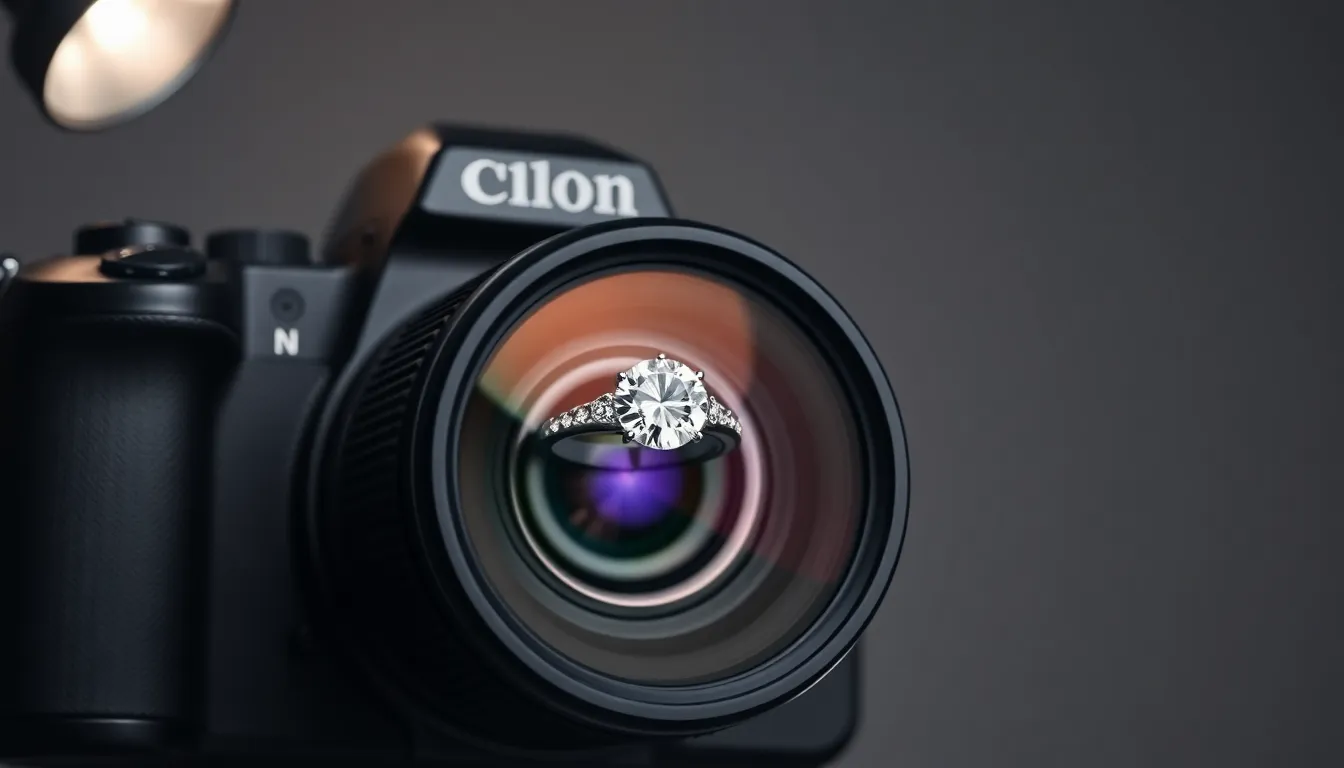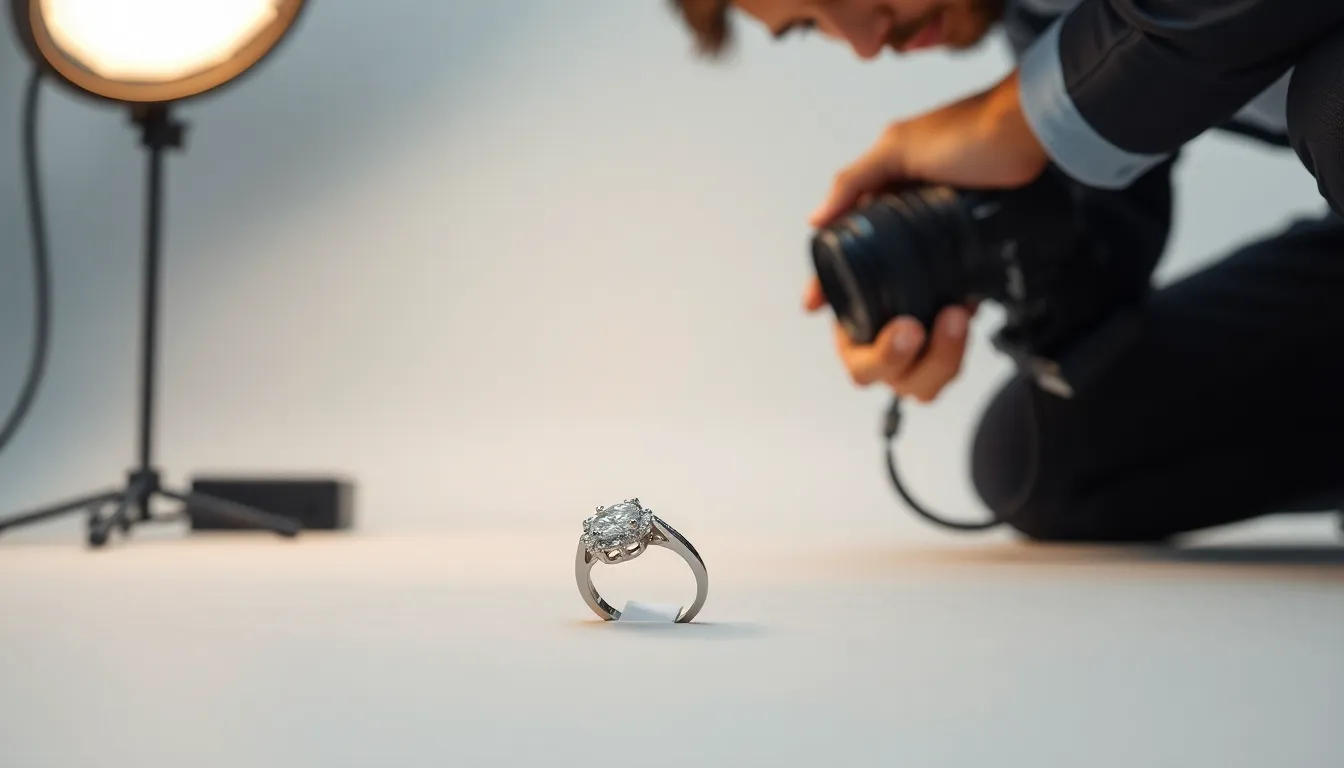Jewelry photography isn’t just about snapping pretty pictures; it’s an art form that can make or break a sale. Imagine trying to sell a stunning diamond ring with a blurry photo that looks like it was taken during an earthquake. Not exactly a confidence booster, right? The right lighting and angles can transform a simple piece into a captivating masterpiece that practically begs to be worn.
Table of Contents
ToggleUnderstanding Jewelry Photography
Jewelry photography showcases pieces in a captivating way, directly influencing consumer decisions. Effective visuals entice buyers, showcasing that quality images are essential for successful sales.
Importance of Good Photography
Good photography acts as a crucial marketing tool for jewelers. High-quality images highlight intricate details, such as gemstone clarity and metalwork craftsmanship. They create a sense of desire among potential customers. Compelling visuals foster trust, encouraging purchases. Research shows that 93% of consumers prioritize images over product descriptions. Effective photography significantly increases conversion rates for online sales platforms.
Common Challenges in Jewelry Photography
Common challenges often arise in jewelry photography, affecting the final image quality. Reflections on shiny surfaces can obscure details, leading to unappealing photos. Inconsistent lighting may create shadows, distorting colors and textures. Jewelers might struggle with background distractions, diverting attention from the piece itself. Achieving the right focus is critical, as it ensures clarity and depth. Techniques like using a macro lens help combat detail loss, making the piece stand out.
Essential Equipment for Jewelry Photography

Proper equipment plays a vital role in achieving exceptional jewelry photography. Investing in high-quality tools enhances the ability to capture intricate details and appealing images.
Cameras and Lenses
Digital single-lens reflex (DSLR) cameras provide excellent image quality, making them ideal for jewelry photography. Mirrorless cameras also offer comparable performance and lightweight options. Macro lenses allow for close-up shots, ensuring even the smallest details of gemstones and settings are sharp. Lenses with a focal length between 90mm and 105mm often produce the best results for jewelry pieces. For versatility, prime lenses also work well, providing clarity and a wide aperture for beautiful background blur.
Lighting Solutions
Proper lighting enhances textures and colors in jewelry photography. Softbox lights create diffused illumination, minimizing harsh shadows. LED ring lights offer even lighting, particularly useful for smaller pieces. Natural light can work, but it is essential to control it by using diffusers or reflectors to soften sunlight. Consistent lighting minimizes reflections and highlights details, leading to compelling images. Continuous light sources easily adjust to achieve the desired atmosphere.
Backgrounds and Props
Simple backgrounds prevent distractions and help jewelry stand out. Neutral colors, such as white or gray, create a clean look that complements the jewelry. Textured surfaces, like wood or fabric, add depth without overwhelming the piece. Props can enhance the story behind the jewelry but should remain subtle. Display stands or elegant boxes can showcase the pieces effectively. Maintaining consistency in backgrounds ensures a cohesive collection when showcasing multiple items.
Techniques for Captivating Jewelry Photography
Engaging jewelry photography requires attention to detail and creative composition. Jewelers can enhance their photography by focusing on composition, depth of field, and post-processing techniques.
Composition Tips
Utilize the rule of thirds to create balanced images. Placing focal points along grid lines draws the viewer’s eye to specific elements, showcasing the piece’s beauty. Experiment with angles, capturing jewelry from various perspectives for a fresh look. Incorporating negative space can emphasize the jewelry, allowing it to stand out against the background. Props, such as elegant fabrics or natural elements, add context and create a story. Avoid cluttered backgrounds, ensuring simplicity to keep the attention on the jewelry itself.
Focus and Depth of Field
Achieve sharp focus on the jewelry by utilizing macro lenses, which excel in capturing fine details. Maintaining shallow depth of field directs attention to the subject, creating a pleasing blur in the background. Testing various aperture settings allows for exploration of different effects, from isolating details to maintaining sharpness across the piece. For added depth, consider layering elements in the foreground or background. Combined strategies of focus and depth result in captivating images that reveal exquisite craftsmanship.
Editing and Post-Processing
Adjustments in editing can elevate jewelry images significantly. Start with cropping and straightening to refine composition. Enhancing brightness and contrast can reveal the metal’s shine and the gemstone’s sparkle. Utilizing tools for color correction ensures that the image accurately represents the jewelry. Highlighting details, such as intricate patterns, can be achieved through careful sharpening. Apply subtle filters or adjustments to achieve a polished look without overshadowing the jewelry’s natural beauty.
Popular Styles of Jewelry Photography
Jewelry photography encompasses various styles, each serving specific marketing needs. Distinct approaches highlight unique aspects of jewelry pieces, enhancing visual appeal and driving consumer interest.
Product Photography
Product photography focuses solely on the jewelry item itself. This style highlights details like cuts and finishes. Clean backgrounds ensure distractions remain minimal. Lighting plays a significant role, as proper illumination enhances colors and textures. Jewelers often use this approach on e-commerce platforms to attract potential buyers. Research shows that high-quality product images can increase conversion rates significantly.
Lifestyle Photography
Lifestyle photography takes a different approach by placing jewelry in relatable contexts. This style captures models wearing pieces in everyday settings, creating emotional connections with potential buyers. It showcases how jewelry complements various outfits and occasions. Consumers respond positively to lifestyle images, often envisioning the pieces in their lives. By incorporating storytelling elements, brands can engage viewers more effectively, enhancing overall appeal and relatability.
Macro Photography
Macro photography emphasizes intricate details that aren’t visible to the naked eye. This technique involves close-up shots that reveal gemstone clarity and metalwork craftsmanship. Jewelers use macro lenses to highlight textures and fine details, making pieces more enticing. Unique angles can showcase the jewelry’s brilliance, attracting viewers’ attention. Macro photography elevates product presentations on websites and social media platforms, driving interest among consumers.
Jewelry photography is more than just capturing images; it’s about telling a story that resonates with potential buyers. By focusing on quality and technique, jewelers can significantly enhance the allure of their pieces. The right equipment and thoughtful composition transform simple photos into powerful marketing tools.
Investing time in mastering photography skills can lead to increased consumer trust and higher sales. With the right approach, jewelers can showcase their unique craftsmanship and create lasting impressions. Ultimately, exceptional jewelry photography not only highlights the beauty of the pieces but also elevates the overall shopping experience.


